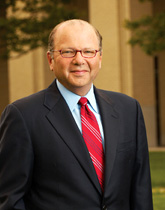Dr. Cohon reappointed president for five more years

There was no 4720 Forbes Avenue. The steeply pitched, overgrown hillside, sandwiched between Carnegie Mellon’s Hamburg Hall and an active railroad track at the bottom of a steep gorge, didn’t hold much appeal. So it remained a small slice of untouched real estate on the edge of the University’s campus.
Enter Jared L. Cohon. Fresh from his job as dean of Yale’s School of Forestry and Environmental Studies, Cohon arrived in Pittsburgh in 1997 as Carnegie Mellon’s eighth president. He quickly established an ambitious list of priorities for the University.
Among his many goals was an initiative that aimed to attract leading technology companies to campus. They’d have ample office and lab space, not to mention easy access to the world-class talent of Carnegie Mellon’s students and professors.
Together, the University-industry dream team could create everything from next-generation wireless and mobile computing devices to sophisticated robotics applications.
But first they had to have a place to work. There didn’t seem to be many options, but Cohon had an idea. He saw something where there was nothing but rocks and dirt—a building site that would make even the most innovative engineers shudder.
Cohon wasn’t deterred.
He and his team selected the site, drafted designs, and secured funding. Ground was broken for the new facility in early 2003. Two years later, there was a 4720 Forbes Avenue. The Collaborative Innovation Center opened its doors and quickly filled to capacity.
Tenants today include Apple, Google, Intel, and Microsoft. In fact, the center has made history by being the only place in the world where these technology giants are housed under the same roof.
Transforming a squalid slope into a hotbed of research and development certainly required vision. So, too, did Cohon’s other ideas.
When he became president, he intended to make dramatic strides in almost every area of University life. Among his goals: increasing the quality and quantity of undergraduate and graduate applicants—in particular, boosting the overall diversity of the student body by admitting students with a broad range of interests and skills with significant leadership potential. He also wanted to create a strong international presence by increasing the number of degree programs offered abroad. And he planned to generate more research funding, boost the University’s endowment, and encourage Carnegie Mellon’s technology transfer operation.
The results are in.
- This year, the University received more than 22,000 undergraduate applications, a record and nearly double the number of applications received during Cohon’s first year in office.
- The University now offers degree programs in 10 countries, an increase from three countries in 1997.
- Sponsored research funding is almost double what it was in 1997, currently totaling $317 million.
- The endowment has grown from less than $600 million to more than $1 billion.
- The University’s technology transfer operation created 14 new start-ups last year alone, an all-time high for Carnegie Mellon and one of the highest rates in the nation. Other successes are obvious throughout the campus.
Carnegie Mellon’s Board of Trustees couldn’t help but notice. When it came time to decide who should lead the University for the next five years, the choice was unanimous.
Cohon looks forward to more success stories. He believes that change is something Carnegie Mellon does very well.
“We really are distinctive, and I say that because our special characteristics are change and innovation,” says Cohon. “Carnegie Mellon has changed every year of its 107 years of existence. It’s always been on an upward trajectory.”
That’s a trajectory he expects to continue.



